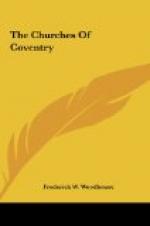[Illustration ST. MICHAEL’S CHURCH.]
CHAPTER II
THE EXTERIOR OF THE CHURCH
The church is built on a site descending towards the east, so that the chancel floor is more than twelve feet above the present street level. The narrow street on the south, Bayley Lane, gives us a succession of picturesque partial views but no general one, while on the north the rather formal avenue dividing the churchyard obscures much of the structure. On the whole, the most comprehensive prospect is to be had from the north-east, at the lower end of Priory Row. But no general point of view is needed, external or internal, to enable us to understand the plan or arrangement, which is almost as simple in form as a village church.
The typical English church plan consists of a nave with aisles, a long unaisled chancel with square east end, porches or doors on north and south, and a western tower, and this, save for its apsidal east end, but amplified by accretions in the form of chapels belonging to the many Gilds of the city, is the plan of St. Michael’s.
In no part, however, do we find the chapels so set as to produce a pseudo-cruciform plan.
Before the latest restoration the walls were entirely of the local red sandstone, very similar in quality and appearance to that of which Chester Cathedral was built, and the extent of its decay, especially on the tower, was as grievous. Hardly a piece of external moulding or carving preserved its original profile or form, and some of the tower buttresses had lost so large a proportion of their substance not far above ground that they appeared to hang to the walls rather than support them. All save the aisles, which were refaced in the sixties, have now been cased with Runcorn Stone nearly the same in colour and much harder in texture.
The special glory of the church is its steeple. No doubt intentionally its height of 300 feet is practically equal to the length of the church. Only one other parish church, Louth in Lincolnshire, has a steeple as high as this, and those of only two English cathedrals, Salisbury and Norwich, exceed it.




